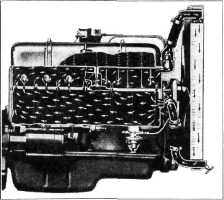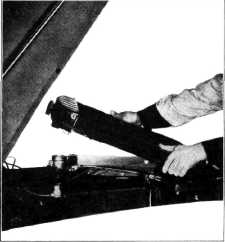1942 - 1947 CHEVROLET SHOP MANUAL
Section 6 - Engine
|
|
|||
|
6-47 |
|||
|
|
|||
|
Reassemble
the cleaner to the carburetor. It must be put on tight and set down so the
felt pad rests against the
carburetor to assure a good seat at this point. Tighten
clamp.
THE COOLING SYSTEM
RADIATOR
The
efficient operation of the cooling system is one of the most important factors in the
satisfactory performance of the automobile engine. The cooling system of the Chevrolet is designed
with two purposes in mind;
first, to carry off a certain amount of the heat created in the engine so
it will not operate at too
high a temperature; and second, to maintain the engine heat at the
temperature which will produce the most efficient and economical operation of the engine. Fig,
100 shows a cross-section view of the cooling
system. |
regular
production thermostat may be replaced with a 166° thermostat when permanent
antifreeze is used in the
cooling system; this will allow a higher water temperature and improve car
heater performance.
Water Jackets
The engine
has full length water jackets, this design provides uniform temperatures for
the full length of the cylinder bores and results in
stabilizing the oil
temperature at a point only 70° above the water
temperature.
The use of
full length cylinder block water jackets necessitates the use of two drain
cocks to completely drain the
entire cooling system. One of
these drain cocks is located at the lower right front corner of the radiator, and the other
at the rear lower left-hand
side of the engine block.
Passenger Radiator Core Removal
To remove the passenger car
radiator core, proceed as follows:
1. Drain the cooling system, remove the
radiator drain cock and rubber hose (located at bottom right front of lower tank—reached up under
front end of car) to prevent
damage when lifting core out. Open hood and block it in the
wide-open
position.
2. Disconnect upper and lower radiator hoses
at radiator. Also loosen hose
clamp on cylinder head outlet
connection and turn hose around so end will be free of radiator. Loosen lower
hose at water pump so the hose
and metal elbow can be turned around to clear the
radiator. |
||
 |
|||
 |
|||
|
Fig. 100—Cross-Section of Cooling System
To
accomplish this job the radiator must be kept free from rust and foreign matter
which might tend to clog the
water passages. The water pump must be leak-proof and must keep the water
circulating in the system.
The water passages in the cylinder block and cylinder head must be free
from rust and corrosion so the
heat may be properly dissipated. All hose connections must be in
good condition and must be kept
tight to prevent leaks. The
cylinder head bolts must be kept tight to eliminate the possibility of strong exhaust
gases entering the cooling
system.
Thermostat
All passenger cars and trucks are
equipped with 140° thermostats. These thermostats will properly control engine temperature under all
conditions except when
permanent anti-freeze is used. The |
|||
|
Fig. 101—Removing Radiator Core |
|||
|
|
|||